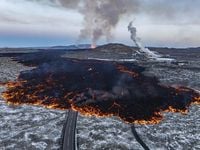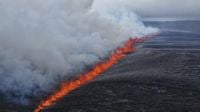Early on the morning of July 16, 2025, Iceland's Reykjanes Peninsula awakened once again with a spectacular volcanic eruption, marking the 12th such event since the region reactivated in 2021. The Sundhnúkur volcano, a dormant giant for 800 years until recent years, began erupting just before 4 a.m. local time, after a swarm of seismic activity rattled the area for two hours, according to the Icelandic Meteorological Office (IMO).
The eruption opened a massive fissure approximately 1.5 miles (2.4 kilometers) long near the Sundhnúkur crater range, southwest of Reykjavik, with a second smaller fissure about 0.3 miles (500 meters) wide emerging west of Fagradalsfjall. Drone footage captured by Hordur Kristleifsson revealed glowing lava streams and the fissures' impressive scale, lighting up the early dawn sky in breathtaking fashion.
Despite the dramatic visuals, officials stressed the eruption remains relatively small and poses no immediate threat to infrastructure. The lava flows are moving southeast, away from populated areas, including the capital Reykjavik. The Icelandic Meteorological Office confirmed, "There is no immediate threat to populated areas or key services," citing stable GPS measurements and low magma output.
However, the eruption prompted swift precautionary measures. Around 100 residents and visitors were evacuated from the nearby town of Grindavik, a fishing community that has faced repeated volcanic threats since the reactivation of the volcano in November 2023. The evacuation, which lasted about 90 minutes, also included the internationally renowned Blue Lagoon geothermal spa and nearby campsites, both popular tourist destinations. Local police commissioner Margrét Kristín Pálsdóttir told the Associated Press, "Of course, people have different opinions on whether the evacuation is necessary, but it is a decision we make and take responsibility for." Thankfully, no injuries have been reported.
The Blue Lagoon, famous for its milky blue, mineral-rich waters set amidst black volcanic rock, remains closed as the eruption continues. Despite this, Iceland's tourism sector continues to operate tours and road trips around the island without interruption, and flights at Keflavik International Airport remain unaffected.
One unusual hazard accompanying the eruption is the presence of "witch's hair," or Pele's hair—fine strands of volcanic glass created when lava droplets cool rapidly and stretch in the air. These tiny glass fibers drift with the wind and can cause skin and eye irritation. The Icelandic Meteorological Office issued warnings urging residents and tourists to be cautious outdoors near the eruption site. Additionally, a significant sulfur dioxide gas cloud is moving north toward Keflavik International Airport, with meteorologists predicting it could pass directly over the airport on July 17. Authorities have advised residents in Reykjanesbær and surrounding areas to stay indoors, close windows, turn off air conditioning, and monitor air quality closely.
The eruption marks the continuation of a new volcanic cycle for the Reykjanes Peninsula that began with the 2021 eruption of Fagradalsfjall, ending an 800-year dormancy period. Since then, the region has experienced 12 eruptions, with the latest being the ninth event since December 2023 alone. This volcanic activity is tied to the region's position atop the Mid-Atlantic Ridge, where the North American and Eurasian tectonic plates are drifting apart, creating rift zones and frequent volcanic activity. The peninsula is also influenced by a mantle plume, or hotspot, which generates excess magma beneath the surface.
Experts describe the eruptions here as fissure eruptions, where magma forces its way through long cracks rather than erupting from a central cone. Thomas Algeo, a professor of earth sciences, explained that these eruptions are "much less dangerous" due to their slow-moving basaltic lava flows, offering spectacular visual displays without explosive ash clouds. Tobias Fischer, director of the Volatiles Laboratory at the University of New Mexico, echoed this sentiment, noting the large magma supplies oozing out of fissures provide "spectacular" views.
Grindavik, once home to nearly 4,000 residents before evacuation orders in 2023, has remained largely deserted due to ongoing volcanic threats. The region's volcanic unrest has been closely monitored by the Icelandic Meteorological Office and the University of Iceland, employing GPS networks, seismometers, drones, and satellite imagery to track seismic activity, gas emissions, and ground deformation.
While this eruption is not expected to disrupt air travel—unlike the infamous 2010 Eyjafjallajökull eruption that grounded over 100,000 flights across Europe—authorities remain vigilant. The 2010 eruption was notable for its explosive interaction between magma and glacial ice, sending ash high into the atmosphere and causing unprecedented airspace closures. In contrast, the current Reykjanes eruptions produce minimal ash and primarily basaltic lava flows.
Former Icelandic president Ólafur Ragnar Grímsson, who served until 2016, shared aerial images of the eruption on social media, remarking, "The creation of the Earth is still going on in Iceland!" His words capture the ongoing geological evolution shaping this island nation.
As the eruption continues, the Icelandic Meteorological Office has updated hazard maps, placing much of the Reykjanes Peninsula under alert. The eruptive fissure has lengthened, extending farther north than previous fissures since December 2023. Lava flow intensity has decreased, with most lava accumulating east of the fissure, likely filling depressions in the landscape. Seismic activity has also diminished, now registering only small earthquakes per hour. However, gas emissions and wildfires contribute to ongoing pollution concerns.
Residents and visitors are advised to follow safety precautions, remain informed through official channels, and respect evacuation orders. The Reykjanes Peninsula's volcanic saga is far from over, with experts anticipating this cycle of eruptions could continue for years or even decades, reshaping Iceland's dramatic landscape and reminding the world of nature's raw power.


